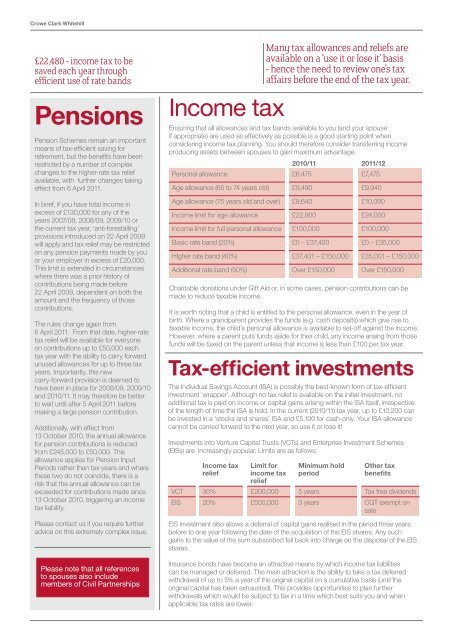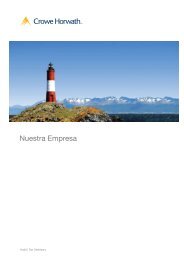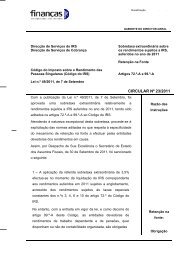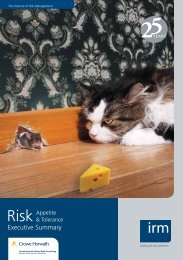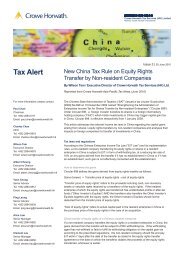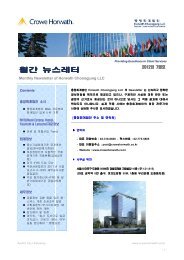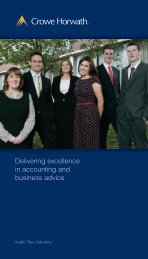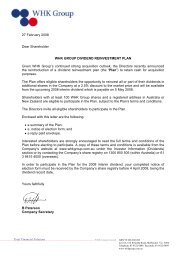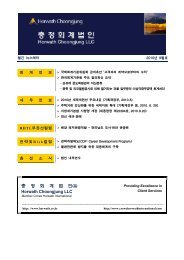March 2011 - Crowe Horwath International
March 2011 - Crowe Horwath International
March 2011 - Crowe Horwath International
You also want an ePaper? Increase the reach of your titles
YUMPU automatically turns print PDFs into web optimized ePapers that Google loves.
<strong>Crowe</strong> Clark Whitehill<br />
£22,480 - income tax to be<br />
saved each year through<br />
efficient use of rate bands<br />
Pensions<br />
Pension Schemes remain an important<br />
means of tax-efficient saving for<br />
retirement, but the benefits have been<br />
restricted by a number of complex<br />
changes to the higher-rate tax relief<br />
available, with further changes taking<br />
effect from 6 April <strong>2011</strong>.<br />
In brief, if you have total income in<br />
excess of £130,000 for any of the<br />
years 2007/08, 2008/09, 2009/10 or<br />
the current tax year, ‘anti-forestalling’<br />
provisions introduced on 22 April 2009<br />
will apply and tax relief may be restricted<br />
on any pension payments made by you<br />
or your employer in excess of £20,000.<br />
This limit is extended in circumstances<br />
where there was a prior history of<br />
contributions being made before<br />
22 April 2009, dependent on both the<br />
amount and the frequency of those<br />
contributions.<br />
The rules change again from<br />
6 April <strong>2011</strong>. From that date, higher-rate<br />
tax relief will be available for everyone<br />
on contributions up to £50,000 each<br />
tax year with the ability to carry forward<br />
unused allowances for up to three tax<br />
years. Importantly, this new<br />
carry-forward provision is deemed to<br />
have been in place for 2008/09, 2009/10<br />
and 2010/11. It may therefore be better<br />
to wait until after 5 April <strong>2011</strong> before<br />
making a large pension contribution.<br />
Additionally, with effect from<br />
13 October 2010, the annual allowance<br />
for pension contributions is reduced<br />
from £245,000 to £50,000. This<br />
allowance applies for Pension Input<br />
Periods rather than tax years and where<br />
these two do not coincide, there is a<br />
risk that the annual allowance can be<br />
exceeded for contributions made since<br />
13 October 2010, triggering an income<br />
tax liability.<br />
Please contact us if you require further<br />
advice on this extremely complex issue.<br />
Please note that all references<br />
to spouses also include<br />
members of Civil Partnerships<br />
Income tax<br />
Ensuring that all allowances and tax bands available to you (and your spouse<br />
if appropriate) are used as effectively as possible is a good starting point when<br />
considering income tax planning. You should therefore consider transferring income<br />
producing assets between spouses to gain maximum advantage.<br />
2010/11 <strong>2011</strong>/12<br />
Personal allowance £6,475 £7,475<br />
Age allowance (65 to 74 years old) £9,490 £9,940<br />
Age allowance (75 years old and over) £9,640 £10,090<br />
Income limit for age allowance £22,900 £24,000<br />
Income limit for full personal allowance £100,000 £100,000<br />
Basic rate band (20%) £0 – £37,400 £0 – £35,000<br />
Higher rate band (40%) £37,401 – £150,000 £35,001 – £150,000<br />
Additional rate band (50%) Over £150,000 Over £150,000<br />
Charitable donations under Gift Aid or, in some cases, pension contributions can be<br />
made to reduce taxable income.<br />
It is worth noting that a child is entitled to the personal allowance, even in the year of<br />
birth. Where a grandparent provides the funds (e.g. cash deposits) which give rise to<br />
taxable income, the child’s personal allowance is available to set-off against the income.<br />
However, where a parent puts funds aside for their child, any income arising from those<br />
funds will be taxed on the parent unless that income is less than £100 per tax year.<br />
Tax-efficient investments<br />
The Individual Savings Account (ISA) is possibly the best-known form of tax-efficient<br />
investment ‘wrapper’. Although no tax relief is available on the initial investment, no<br />
additional tax is paid on income or capital gains arising within the ISA itself, irrespective<br />
of the length of time the ISA is held. In the current (2010/11) tax year, up to £10,200 can<br />
be invested in a ‘stocks and shares’ ISA and £5,100 for cash-only. Your ISA allowance<br />
cannot be carried forward to the next year, so use it or lose it!<br />
Investments into Venture Capital Trusts (VCTs) and Enterprise Investment Schemes<br />
(EISs) are increasingly popular. Limits are as follows:<br />
Income tax<br />
relief<br />
Many tax allowances and reliefs are<br />
available on a ‘use it or lose it’ basis<br />
- hence the need to review one’s tax<br />
affairs before the end of the tax year.<br />
Limit for<br />
income tax<br />
relief<br />
Minimum hold<br />
period<br />
Other tax<br />
benefits<br />
VCT 30% £200,000 5 years Tax free dividends<br />
EIS 20% £500,000 3 years CGT exempt on<br />
sale<br />
EIS investment also allows a deferral of capital gains realised in the period three years<br />
before to one year following the date of the acquisition of the EIS shares. Any such<br />
gains to the value of the sum subscribed fall back into charge on the disposal of the EIS<br />
shares.<br />
Insurance bonds have become an attractive means by which income tax liabilities<br />
can be managed or deferred. The main attraction is the ability to take a tax deferred<br />
withdrawal of up to 5% a year of the original capital on a cumulative basis (until the<br />
original capital has been exhausted). This provides opportunities to plan further<br />
withdrawals which would be subject to tax in a time which best suits you and when<br />
applicable tax rates are lower.


